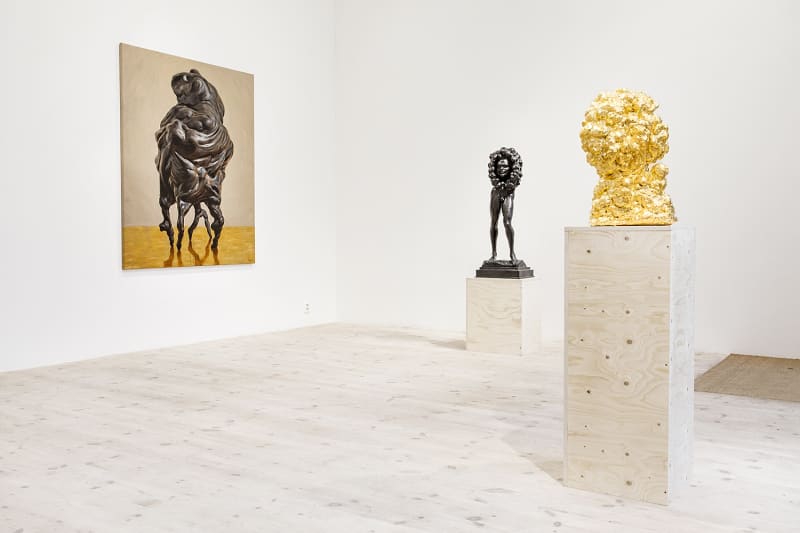It came back and larger: Willem Andersson
Willem Andersson presents a selection of new paintings and sculptures in his latest solo exhibition "It Came Back and Larger" for reasons others may not ever pinpoint. That is Andersson's trick-exercising his power to present work which seldom relates to the actual. There is no guarantee that his stimuli will enliven, influence or even bless those who stumble upon them. This Delphic collection mirrors and refracts, to an extent, previous work by the artist, as he highlights a coincidental connection to the poetry of Elizabeth Clark Wessel.
Andersson's oeuvre cajoles with the cryptic and parenthetical; what is unsaid, implied or hidden can hold more worth than what obviously stands-especially, if the factual proves to be hypocritical or torturous. There is value in the uncanny, if even oddly wicked or thwarted in its surreal composition. Do the times beg for a new witchcraft? For better or worse, the tripwire between 'good' and 'evil' has been set off. The manic and rare roam within the walls of the white cube. Andersson's obscurantist graphics fuel a preternatural alternative; it is the abnormal that we lust after-the clinamen, anomaly, freak. His new works present voluptuous figures suffocating in an oily, ebony substance, and other shapes drown in bulbous gold. Certain globular organisms are destined to be terminally alone, and others cling together-slick limbs bound in a macabre permutation of Henri Matisse's La Danse (1909).
As in the poetic verse of Jorge Luis Borges, Arthur Rimbaud and John Ashbery, the conclusion is never as remarkable as the scene which stages the phantasmagorical framework, with words crafted to allow for a hushed soliloquy or unreal tension. Relayed via voice or with visual catalysts such as Andersson's faceless docile crowds, his fertile towers, suited phantoms of anonymity, eclipsing planets, ethereal kings, spiral staircases to Hell & back, silent sirs, askew séances, doll house dimensions, alien soldiers donning shimmery medallions once territorializing escapist realms and uneasy nations never to exist, or conventional sheep infinitely swayed by the herd-his archive of feral panoramas entice those intrigued by raw possibility. Objects and faces appear in other works in a layered, meta-referential manner.
In these works, words easily become image, or vice versa, in an ekphrastic interplay of transmutation. One may attempt to enter a room and remain intact upon exit, but it's not recommended to shun someone's tenacity. Usually painful or awkward, one may gaze upon the sublime and realize that returning to the usual grind or safe pattern is no longer feasible. Art remains as dangerous as religion; similar to its heavenly verse, a creation's impact on an arbitrary entity is not guaranteed to placate. A once harmless image or view can easily trigger a response for justifiable revolt. A nominal shift may ignite magnified consequences in a more complex system-i.e., The Butterfly Effect. An artwork can be noted as natural phenomenon, similar to the wind's direction or a virus, yet Andersson's exhibited inscape resembles a shiv. Works initially embedded within one's dream state are precarious; they illuminate (carve?) lucid pathways once overlooked or masked.
In The Gift of Death, Jacques Derrida refers to the philosophy of Jan Patoĉka who relates secrecy or 'the mystery of the sacred' to responsibility: " 'The demonic is to be related to responsibility; in the beginning such a relation did not exist' […] the demonic is originally defined as irresponsibility, or, if one wishes, as nonresponsibility. It belongs to a space in which there has not yet resounded the injunction to respond; a space in which one does not yet hear the call to explain oneself [répondre de soi], one's actions or one's thoughts, to respond to the other and answer for oneself before the other." Let us say that in this space before responding, there exists justification for a possessed rapture, for liberty, where the 'self' comes before the 'other.' Unabashed self-love is a prerequisite to enjoy Andersson's abstruse aesthetic; one who succumbs to the interfering sentiments of others may never be affected by the image or object. The artist flirts with secrecy; he toys with coded visuals which offer access to a once private wilderness. But the 'welcome' falls short for those chained to responsibilities-for the trapped. Like death, sleep is a gift. Andersson's netherworld motivates the living to migrate, hunt and find-so as to return full-force.
- Jacquelyn Davis


